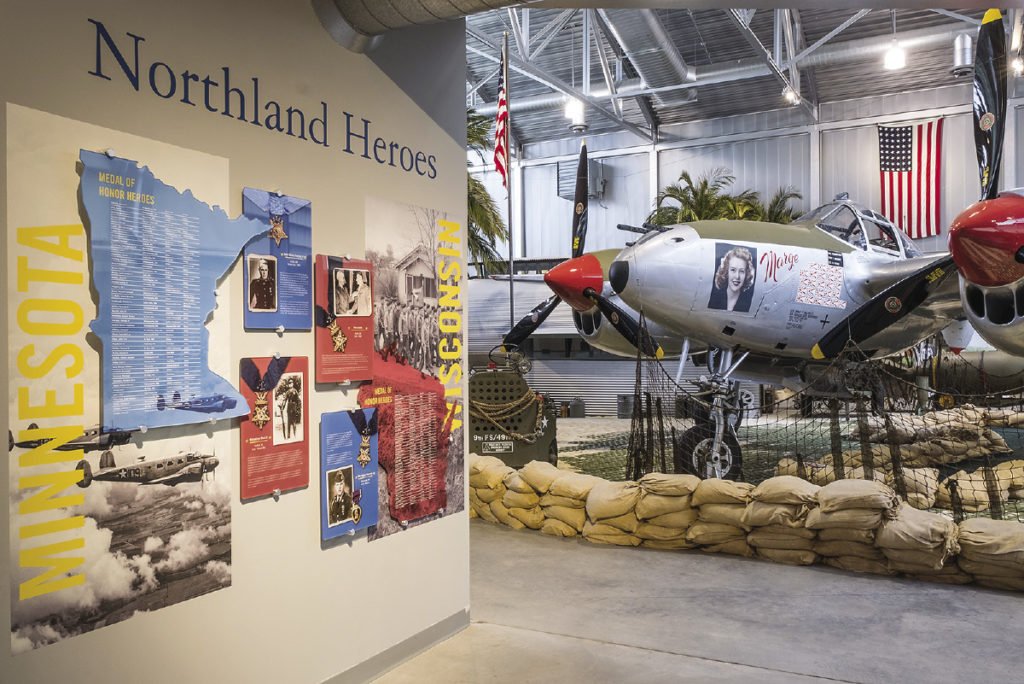The roar of an F-16 fighter jet passing overhead is a sound that isn’t so much heard as it is felt by a person watching from ground level.
Anyone who has spent significant time on the North Shore is familiar with that roar, and has had a moment interrupted by a fighter jet’s awesome rumble as the 148th Fighter Wing, based out of Duluth, runs a routine practice flight along Superior’s shore.
The F-16’s based out of Duluth, along with the commercial airliners that pass by 35,000 feet up in the sky and the modern personal jets designed and manufactured by the locally headquartered Cirrus Aircraft, are but the most recent chapter in aviation history on the North Shore.
North Shore aviation has a fascinating history, one well worth discovering. The following are a few of the different organizations in the region that dedicate themselves to the continued preservation of aviation history on the North Shore.
Richard I. Bong Veteran’s Historical Center
The Richard I. Bong Veteran’s Historical Center, located at 305 Harbor View Parkway in Superior, Wisc., is a must-see for anyone who fancies themselves an aviation enthusiast.
What started as a foundation to raise funds for a Richard Ira Bong memorial, is now a much larger organization whose mission has expanded to not only preserve and honor the memory of Major Bong, but to do so for “all veterans of World War II and the subsequent conflicts by providing educational resources for the Twin Ports area community and beyond.”
The Historical Center is home to a state-of-the-art museum that boasts an impressive collection of over 10,000 artifacts, as well as archives containing over 3,000 books, manuscripts, yearbooks, personal letters, photographs, scrapbooks and newspapers. A P-38 fighter plane—donated by the American Legion Post 435 in 2000—stands impressively in the center of the museum in honor of Major Richard I. Bong.
Fascinating and engaging—the museum is well worth the visit.
According to the historical center, Richard I. Bong was a WWII fighter pilot who became the United States’ all-time “Ace of Aces” during the war, “downing 40 enemy planes in the Pacific Theater of the war while flying P-38 fighter planes.” Major Bong was eventually sent home by General George C. Kenney to marry his sweetheart, Marge, and start a family in Superior.
Born and raised on a farm in nearby Poplar, Wisc., Richard I. Bong’s upbringing “epitomized the values and expectations of that era,” making him a true American hero. Major Bong was awarded the Congressional Medal of Honor by General Douglas MacArthur in 1944, a year before Richard Bong’s tragic death during a test flight of a new P-80 Fighter Jet.
While Major Bong may be gone, his story—along with the stories of other veterans from WWII and subsequent conflicts—lives on in the Veteran’s Historical Center that bears his name.
For up to date hours, events, and information on the Richard I. Bong Veteran’s Historical Center and its mission, visit: bongcenter.org.
Northwestern Ontario Aviation Heritage Center
On the other end of the shore from the Bong Museum, the Northwestern Ontario Aviation Heritage Center (NOAHC) is an organization dedicated to the continued preservation of aviation history in the North. The NOAHC covers aviation history in an area that expands across nearly 50 percent of Ontario—526,372 square kilometers—making it a regional center despite its location in Thunder Bay.
The idea for the heritage center first came about in 2006 when the retired aeronautical engineer Victor Stevenson brought together a group of aviation enthusiasts with the goal of establishing a museum to preserve the story of the Canadian Car and Foundry’s (Can-Car) contribution to aviation history. Though not limited to producing planes during wartime, Can-Car is best known for the Hawker Hurricane fighters and Curtiss SB2C Helldivers that it manufactured during WWII.
As the aviation “enthusiasts” continued to work towards establishing a museum, however, it became apparent that there was a larger story beyond Can-Car that needed to be told, a story that included both “the civilian and military history of aviation in the region with all of its tales of heroism, courage, ingenuity, laughter, and tragedy,” as described on the NOAHC webpage.
Established in 2008, the museum today not only takes visitors through Can-Car’s story and the 4,000 “Rosie’s of the North” that contributed planes throughout WWII, but also immerses its visitors in the daring tales of the bush pilots that made life and industry in the remote North possible.
Exhibits are well laid out and easy to follow, with photos and artifacts on display that take the viewer back to a time before modern navigation aids and accurate weather reports, when flying was, to quote the NOAHC, “a seat-of-the-pants affair.”
For further information on Northwestern Ontario Heritage Center events, hours, and special tours, visit their website at: noahc.org.
Discover Geraldton Interpretive Center
In addition to the Richard I. Bong Veteran’s historical center and the NOAHC, the Discover Geraldton Interpretive Center (GIC) is an interpretive center that delves into aviation history in its telling of the region’s history.
Located in Geraldton, Ontario along Highway 11, the discover GIC offers visitors the opportunity to “explore the early days of the Hudson Bay Fur Traders, the gold boom that brought the town of Geraldton into being, and the firefighting legacy that is ours today.”
Further information to events and summer hours can be found on their webpage at: bit.ly/greenstoneic.

